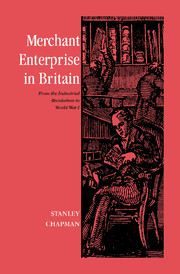Book contents
- Frontmatter
- Contents
- List of figures
- List of tables
- Preface
- Abbreviations used in the footnotes
- Introduction: approaches and concepts
- Part I The setting
- Part II New Streams Of Enterprise
- Part III Response to instant communication
- Chapter 7 Problems of restructuring mercantile enterprise
- Chapter 8 British-based investment groups before 1914
- Chapter 9 Imperialism and British trade
- Part IV Conclusions
- Manuscript sources
- Index of firms and people
- Index of places
- Index of subjects
Chapter 9 - Imperialism and British trade
Published online by Cambridge University Press: 20 March 2010
- Frontmatter
- Contents
- List of figures
- List of tables
- Preface
- Abbreviations used in the footnotes
- Introduction: approaches and concepts
- Part I The setting
- Part II New Streams Of Enterprise
- Part III Response to instant communication
- Chapter 7 Problems of restructuring mercantile enterprise
- Chapter 8 British-based investment groups before 1914
- Chapter 9 Imperialism and British trade
- Part IV Conclusions
- Manuscript sources
- Index of firms and people
- Index of places
- Index of subjects
Summary
In the introduction to this book some initial reference was made to mercantile strategies in relation to the development of the British Empire. Professor D. C. M. Platt, a specialist on Latin America, sees the concentration on trade and investment within the bounds of Empire as a perfectly rational strategy, given the low returns and high risk associated with enterprise in that continent. British trading interests there gradually declined in relative importance as the century advanced, and the revival of investment interest in the 1870s and 1880s suffered a severe setback with the infamous Baring crisis of 1890, which brought the most prestigious gentile merchant bank in London to its knees. A comparable withdrawal from trade in Tsarist Russia has also been seen as inevitable.
The Platt thesis has found support in earlier chapters of this book to the extent that it has been recognised that the major British trading houses were increasingly to be found in India, British colonies in the Far East, South Africa, Australia and other Empire countries. The case histories of particular commodities have also revealed shifts towards Empire trade. Grain, once drawn from the Baltic and Black Sea, was increasingly imported from North America and India, and there were various attempts to promote cotton cultivation in India. Tea and rubber were transplanted to appropriate imperial territories, while the most vigorous arm of the export trade in textiles, the City warehouses, marked out a chain of imperial stations (see Chapters 3, 5).
- Type
- Chapter
- Information
- Merchant Enterprise in BritainFrom the Industrial Revolution to World War I, pp. 262 - 284Publisher: Cambridge University PressPrint publication year: 1992

